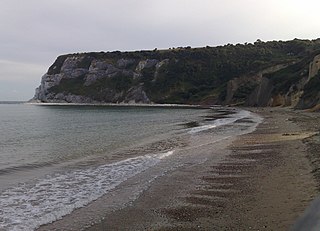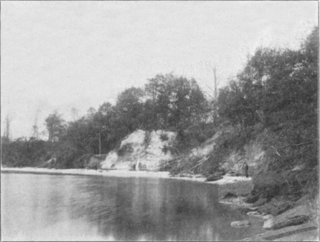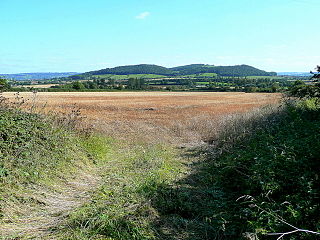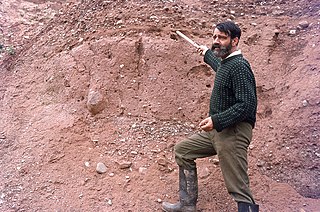
Craterosaurus was a genus of stegosaurid dinosaur. It lived during the Early Cretaceous around 121-113 million years ago. Its fossils were found in the Woburn Sands Formation of England. Craterosaurus may actually be a junior synonym of Regnosaurus, but only one fossil, a partial vertebra, was recovered.

Court Hill is a 10.45 hectare geological Site of Special Scientific Interest near the town of Clevedon, North Somerset, England, notified in 1997.
Teffont Evias Quarry and Lane Cutting is a 3.6 hectare geological Site of Special Scientific Interest at Teffont Evias in Wiltshire, England, notified in 1989. It consists of two parts, Teffont Evias Quarry, and Teffont Evias Lane Cutting. Forest trees are currently growing on both sites, but there are small accessible exposures on the sides of quarry and roadway cuttings.
The Geological Survey of India (GSI) currently maintains two protected areas bearing rich fossil deposits.

Bramerton Pits is a 0.7-hectare (1.7-acre) geological Site of Special Scientific Interest north of the village of Bramerton in Norfolk on the southern banks of the River Yare. It is a Geological Conservation Review site.

Whitecliff Bay is a sandy bay near Foreland which is the easternmost point of the Isle of Wight, England, about two miles south-west of Bembridge and just to the north of Culver Down. The bay has a shoreline of around three-quarters of a mile (1.2 km) and has a popular sandy shingle beach which is over half a mile long. It is a tourist site with three holiday parks in the vicinity of the bay; it has two cafes though minimal facilities. Access is limited and only possible down two steeply sloping concrete tracks.

The Raritan Formation is a Cretaceous (Turonian) sedimentary geologic formation of the Atlantic Coastal Plain.
Cloverdale is an unincorporated community in Lane County, Oregon, United States. It is approximately 3 miles (5 km) northeast of Creswell on Oregon Route 222.
The Kattendijk Formation is a five million years old marine geological formation north of Antwerp, Belgium. including the north-western parts of the Campine region. The area was named by De Heuter and Laga in 1976. The sands range from medium fine to coarse and contain a large proportion of shell grit.

Alderton Hill Quarry is a 0.34-hectare (0.84-acre) geological Site of Special Scientific Interest in Gloucestershire, notified in 1997. It is a Geological Conservation Review (GCR) site.
Land Grove Quarry, Mitcheldean is a 3.8-hectare (9.4-acre) geological Site of Special Scientific Interest in Gloucestershire, England, notified in 1974. The site is listed in the 'Forest of Dean Local Plan Review' as a Key Wildlife Site (KWS).

Nibley Knoll is a 3.2-hectare (7.9-acre) geological Site of Special Scientific Interest in Gloucestershire, notified in 1974. The site is listed in the ‘Stroud District’ Local Plan, adopted November 2005, Appendix 6 as an SSSI and a Regionally Important Geological Site (RIGS).
The Alum Bluff Group is a geologic group in the states of Georgia, Florida, and Alabama. It preserves fossils dating back to the Neogene period.

The Coralline Crag Formation is a geological formation in England. It is a series of marine deposits found near the North Sea coast of Suffolk and characterised by bryozoan and mollusc debris. The deposit, whose onshore occurrence is mainly restricted to the area around Aldeburgh and Orford, is a series of bioclastic calcarenites and silty sands with shell debris, deposited during a short-lived warm period at the start of the Pliocene Epoch of the Neogene Period. Small areas of the rock formation are found in locations such as Boyton and Tattingstone to the south of Orford as well as offshore at Sizewell.

Russell Coope, also Geoffrey Russell Coope and G. Russell Coope was a Quaternary paleoentomologist and neontologist and a paleoclimatologist specializing in the British Pleistocene. He was an expert and leader in the reconstruction of Quaternary paleoenvironmental conditions from fossil beetles. The relatively young age of his fossils allowed Coope to explore construction sites for fossils, in addition to geological field sites.

Dryhill is an 11.7-hectare (29-acre) geological Site of Special Scientific Interest on the western outskirts of Sevenoaks in Kent. It is a Geological Conservation Review site, and an area of 9.5 hectares is a Local Nature Reserve

Spot Lane Quarry is a 0.1-hectare (0.25-acre) geological Site of Special Scientific Interest on the eastern outskirts of Maidstone in Kent. It is a Geological Conservation Review site.
The Algoa Group is one of five geological groups which comprise the coastal Cenozoic geological deposits in South Africa. The Algoa Group contains six formations which range from Middle Eocene to Late Holocene in age.

Glandford (Hurdle Lane) is a 9.4-hectare (23-acre) geological Site of Special Scientific Interest west of Sheringham in Norfolk. It is a Geological Conservation Review site and it is in the Norfolk Coast Area of Outstanding Natural Beauty.

Hegetotherium is an extinct genus of mammals from the Early to Middle Miocene of South America. Fossils of this genus have been found in the Cerro Bandera, Cerro Boleadoras, Chichinales, Collón Curá, Santa Cruz and Sarmiento Formations of Argentina, the Nazareno Formation of Bolivia, and the Galera and Río Frías Formations of Chile.














